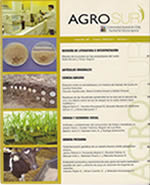Stoking rate and grazing capacity of Chilean Patagonian rangeland: Estimation at the county level
Main Article Content
Abstract
A study was conducted to determine the Livestock farm intensity coefficient, by the ratio between the stocking and carrying capacity of grazinglands of the Los Ríos, Los Lagos, General Carlos Ibanez del Campo (Aysén) and Magallanes and Chilean Antarctica (Chilean Patagonia) regions. The current stocking rate was determined through 2007 Livestock Census information and coverage crosses regarding pastoral rangelands at the county level, and it was compared which the carrying capacity. The latter variable was calculated from the average rangeland DM annual production, which was estimated at regional level through a simple model based on a series of 10-year-MODIS NDVI images with a pixel size of 6.25 ha approximately. Preliminary results of this analysis indicate that the rangelands of the Chilean Patagonia present high spatial variability in terms of their annual DM production. Los Lagos and Los Rios regions are those with higher stocking density, showing them the highest degree of human intervention, which in many cases results in a situation of overgrazing, contrary to what happens in many counties of the Aysén region. In this respect, the Magallanes Region presents degrees of use near the optimum, an aspect that should be taken with caution since the estimates of the model PMSA vs NDVI in shrublands and bunchgrass grassland seem to be less plausible.

